Tree Farming 101
Tree cultivation is a lengthy endeavor. Multiple methods exist for generating income from trees, all of which require time to yield results.
The initial costs can be intimidating, but after planning and setup are out of the way, profits become steady and predictable.
Be it fruit, nuts, or wood; many tree products are incredibly valuable with hungry markets looking to buy.
If you have the capital to get started, the will to plan ahead, and the patience to wait for trees to mature, you can have great success growing trees for profit.
How Do Tree Farms Make Money?
Plain and simple, tree farmers make money by selling trees or products from trees. While this is the same for all tree farmers, how they go about it varies greatly.
The best system for you depends on your growth, location, climate, and funding.
Here are the most popular ways to make money growing trees.
Tree Nursery
A nursery is a business that propagates, grows, and sells young trees and shrubs. Some nurseries start plants from seed, and others start with seedlings or cuttings.
Depending on the plant, season, and market, trees and shrubs can be sold at different ages. For example, a fruit tree can be sold at the one, three, five, or even ten-year mark.
Customers who want the lowest upfront cost will buy young trees from a nursery, whereas ones that prefer speed and convenience at a higher price will get mature trees.
This rolling sales cycle makes tree nurseries a unique and flexible business.
If your plants don’t sell, they don’t go to waste and you don’t lose money, they just appreciate in value and roll over into a new sales tier.
Remember, tree nurseries can be a part of many different tree farms, but a nursery in itself isn’t for producing any products from trees, just the plants themselves.
Fruit and Nut Trees
One of the most obvious ways to make money farming trees is to grow specific types that produce high-value food products like fruits and nuts.
Most people are familiar with the concept of an orchard or a plot of land explicitly used for trees that produce food products.
There are many ways to make money with an orchard, but no matter what, your business will revolve around specific food products.
Let’s use apples as an example.
Depending on the climate in your area and your local market, there are dozens of varieties you can choose from. Once you choose the variety, you need to connect with a tree nursery and invest in some seedlings.
Once you get those young trees in the ground or pots, it will be several years before they start producing fruit.
Alternatively, you can buy older trees for a premium or even buy an existing fruit/nut operation with trees that are already fruiting.
Once trees come to maturity, they will continue to bear fruit for many years – this is when you start to make back your initial investment.
With the products you harvest from the trees, you can do loads of things.
With apples, you can sell them fresh to stores, sell them at a farmers market, have customers home to your site to pick them or process them into cider, juice, or snacks.
Most apple farmers use some combination of these options for a diverse cash flow.
Other than apples, popular crops include walnuts, almonds, peaches, pears, oranges, avocados, pistachios, and more.
Trees For Wood and Fiber
Believe it or not, planting trees specifically for wood can be incredibly lucrative.
There is a high demand for many types of wood, and most of the work comes upfront, after which it’s mostly a waiting game.
Specialty woods are used to make furniture and instruments, while other wood (usually easier to grow) is in high demand for industrial use or as construction material.
Fibers from many trees are used for clothing, rope, or crafting.
Planting forests on your property is an excellent long-term investment. It will take years for the trees to grow, often 25 years or more, but the profits are enormous, and they don’t take much day-to-day work.
Many farmers use this method to set themselves up for retirement or legacy purposes.
Once your timber trees are mature and ready for sale, the best option is to sell them via a woodlot harvest.
You can find buyers and programs through your state’s forestry or natural resources division or extensions at local universities.
Additionally, you can hire a professional forestry consultant. These agents can advise you on tree planting, forest management, valuations, harvest, and sale.
Once you contact a buyer, they will usually hire workers and machinery to come to your property and harvest the wood as a part of the agreement.
Landscaping Trees
Another great option is to grow trees for landscaping.
Ornamental trees and shrubs and ones that provide shade are always in high demand.
Trees like Japanese maple, star magnolia, crabapple, flowering dogwood, sugar maple, arborvitae, blue spruce, and desert willow add beauty and color to the landscape.
Shrubs like rose, holly, lilac, azalea, flowering quince, and spirea have a smaller footprint with beautiful flowers perfect for front yards.
These trees and shrubs can be sold to garden supply centers, directly to customers, or sold wholesale to landscaping companies.
The sheer volume of plants that a successful landscaping company goes through makes working with them an incredibly lucrative opportunity if you can meet their demand.
Landscaping trees can also be used to lower a building’s heating costs in the summer.
The shade of a tree isn’t just the perfect place for a picnic, it can block the sun’s rays from beaming on the side of a house, which significantly raises the indoor temperature and leads to more expensive and eco-harming energy consumption.
Many homeowners know this and will pay top dollar for great shade trees to make their yard and home more comfortable and efficient.
What’s Needed To Start A Tree Farm
What you need to start a farm and how it will ultimately run depends on many factors.
For example, do you have many acres of land or only a small plot? Will you plant trees in the ground or containers? Will you sell saplings, nuts, fruits, wood, or some combination of these?
To make things simple, here’s a list of everything you will need to start a tree farm, regardless of your goals.
1. Land
Whether you are growing in-ground or in-pot you need a space for your plants to live and grow. This can be hundreds of acres or just a porch or backyard.
2. Soil
Next, you need fertile soil. For in-ground planting, you ideally want a balanced soil type without many rocks.
If you are growing in pots, you can buy the perfect soil for your plants online or from a store, but you can expect to pay a premium for it.
3. Irrigation
All plants need water to live. Some trees, like hearty types grown for wood, will grow well with nothing but rainfall, whereas others need controlled and constant watering.
Plastic drip irrigation is the best option for most growers. Depending on the size of your operation, you may want to dig a well on your property to provide the water.
4. Seeds, cuttings, or seedlings
Most growers buy young trees and mature them on-site. You can get these from a local nursery, buy them online, or grow them yourself.
Once you have your initial crop of trees, you can propagate future trees from your own cuttings, saving loads of money in the long run.
If you plan on growing in pots, the containers you use and the soil you fill them with will be another large consideration.
Also, many growers can benefit from a greenhouse for plant propagation.
Lastly, basic gardening and farming tools are needed. Things like pruning shears, hoes, and rakes will come in handy.
Choose from Thousands of Trees & Plants, Delivered with Care, Directly to Your Home.
- Indoor/Outdoor
- Fruit/Flower
- Privacy/Decorative
- and more!
Popular & Profitable Trees To Grow
Arborvitae
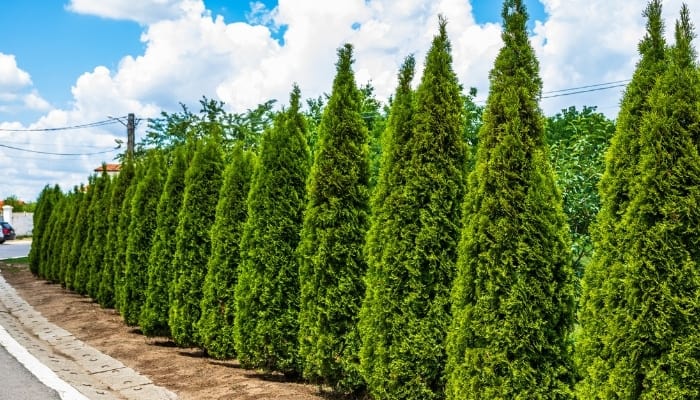
Arborvitae trees are evergreens that are highly sought after for landscaping purposes.
When planted in a tight row, these trees form a green wall. This is great for adding privacy to your yard or as a windbreak. Arborvitae is a great tree to grow because customers almost always purchase multiple trees at a time.
Arborvitae trees are easy to trim and shape, either enhancing their natural shape or transforming them into something unique.
Christmas Trees
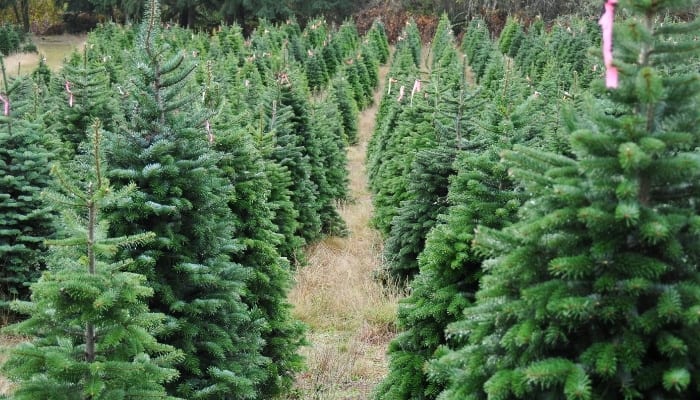
Everyone loves a fresh Christmas tree. Nothing beats the look, feel, and smell of the real thing.
Growing Christmas trees and selling them for cash is a huge industry. Compared to other trees, these are quite easy to manage for beginners.
There are dozens of varieties to grow, including Douglas Fir, Scotch Pine, Balsam Fir, and Fraser Fir.
These trees can be planted tightly together, either in 5×5 rows (1,700 trees per acre) or 6×6 rows (1,200 trees per acre). While you may be tempted to squeeze as many trees as possible onto your plot, leaving some space between the trees allows for easier harvesting and lowers the chances of disease spread.
The average Christmas tree grows about a foot per year for six to eight years before it’s ready to harvest and sell. According to MarketWatch, the average price for a Christmas tree in 2018 was $78.
With 6×6 spacing, an acre of Christmas trees at this price would be worth around $93,000 after a minimum of six years.
The expenses on such an operation would mostly come down to labor, but also include the cost of seedlings/cuttings and equipment and machinery costs.
Once you have your trees, you can sell them in a few different ways. First, you can sell them on-site, inviting customers to walk your field and pick out their tree. This is great fun for families and a smart way to build return customers.
Alternatively, you can sell trees wholesale to a secondary retailer like a garden center. Doing this, you will net less on each tree but you can move huge volumes by taking advantage of the marketing and existing customer base of an established retailer.
This is a seasonal job that can be diversified with other trees or plants in the off-season. But, even if you want to grow Christmas trees as a side hustle, it can be a great choice because it is so low maintenance.
Japanese Maple
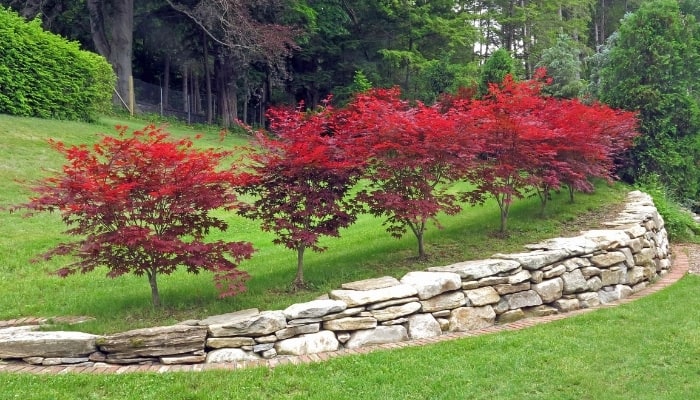
Japanese Maples are prized for their brightly colored leaves and bonsai-like shape. There are dozens of varieties of Japanese Maple, some with red leaves, others with yellow, orange, or purple.
These trees are so striking that they are often used as the centerpiece of a landscape design. Customers are willing to pay top dollar for great Japanese Maple specimens.
Being small- to medium-sized trees, around eight to thirty feet tall, Japanese Maples are a great high-value option for growers with less land. Either grown in the ground or containers, they can pack an enormous value into a tiny space.
The price that Japanese Maples sell for depends on their age. You can sell seedlings for roughly $5 to $15, sell young trees for $50 to $100, and the price goes up and up the older they get.
This makes for a flexible sales cycle. What you don’t sell immediately continues to grow and appreciate.
Nut Trees
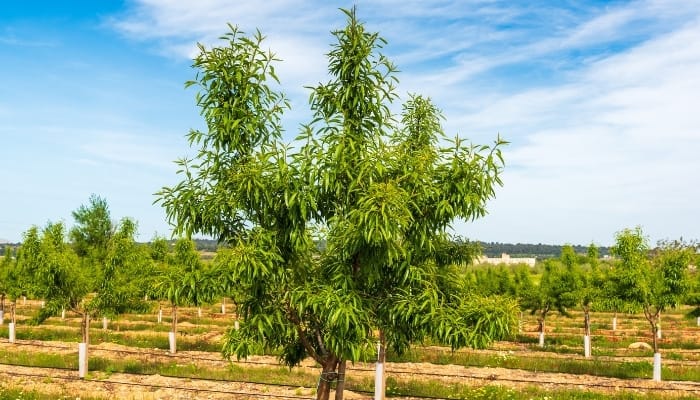
Nut trees are incredibly lucrative for both their nuts and their wood, depending on the type and variety.
Depending on how they are grown and pruned, they can be specialized for nut or wood growth. For example, walnut trees can be allowed to grow wide, which stimulates nut growth. These will yield delicious valuable nuts in just over four years.
Alternatively, you can push your trees to grow tall and straight which leads to better quality wood but fewer nuts. Walnut wood is used in furniture, flooring, cabinets, carvings, and gunstocks and is very valuable.
Popular nuts to grow include walnut, almond, pistachio, macadamia, chestnut, and pinenut.
Managing an orchard of nut trees can be difficult and technical, but incredibly profitable.
If this doesn’t suit you, even a small number of nut trees can be added to your property to add value to the land and bring in a nice little harvest.
Fruit Trees
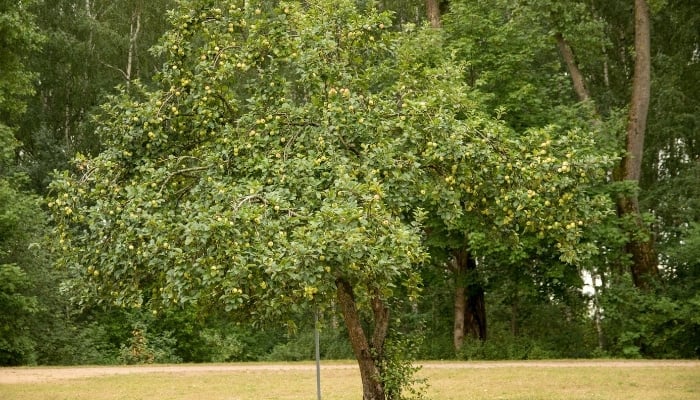
Fruit trees are similar to nut trees in that they can be useful for food and wood, and are tricky to manage.
At the simplest level, having an apple tree on your farm requires almost no work and can lead to a few bushels of apples each year.
However, a more sophisticated operation requires precise planning and significant upfront costs. But once you get these out of the way, managing an orchard is incredibly rewarding. The workload scales down significantly after the first few years have passed.
Just like other trees, fruit trees can be cut and grafted for further propagation. This means you can get virtually infinite trees off of an initial batch.
Popular fruit includes apples, peaches, pears, oranges, lemons, and avocados.
Bonsai
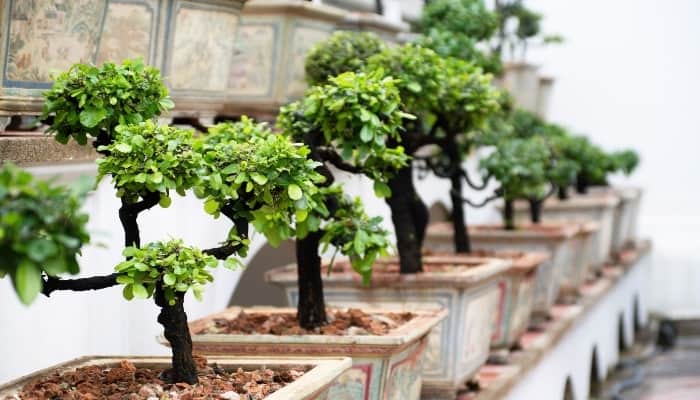
Bonsai trees are tiny specialty trees used as decorations. Because of their history, beauty, and the expertise required to grow and prune them, Bonsai trees are incredibly high-value trees, especially for their size.
Even with a tiny area, you can run a substantial Bonsai business.
Despite what pop culture would have you believe, growing and trimming Bonsai trees isn’t a sacred art shrouded in mystery. Anyone (with a bit of practice) can learn to make them.
There are several varieties of Bonsai to choose from. Some varieties do better in warm climates, others in cold ones, and some can even be grown indoors.
Willow
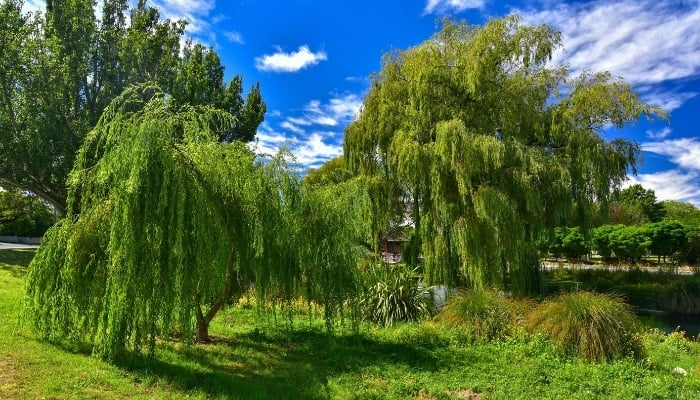
Willow trees are majestic and unique trees that are used for landscaping and fiber.
These trees can be tricky to grow, despite their hardiness. They can survive in zones 2 through 9 and do well in wet areas.
The issues with willow trees are numerous pest problems, invasive roots that can mess up your lawn or crack concrete, and brittle branches that break easily in high winds or after a harsh winter.
They also need plenty of space to grow, as some of them get to be fifty feet high and wide.
You can grow willows specifically for fiber, but this requires a different approach. Rather than letting them grow normally, they are coppiced, meaning the young growth is cut down to allow new shoots.
These shoots are long and flexible and can be harvested and sold for basket weaving and other crafts.
Moringa
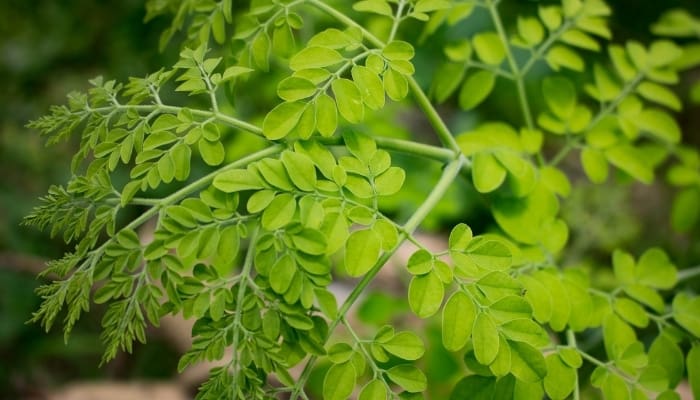
Moringa is an exotic tree grown for its super nutritious leaves and seeds.
Moringa prefers warm tropical and subtropical climates but can withstand light frosts. It is tolerant to dry conditions that would harm most other trees.
The leaves are cooked or used in salads and the nuts are eaten raw or turned into powder. Each of these products is packed with nutrients and very desirable within the health food community.
You can sell these products directly to customers or retailers. The trees themselves can also be sold for landscaping purposes as shade trees.
Palm
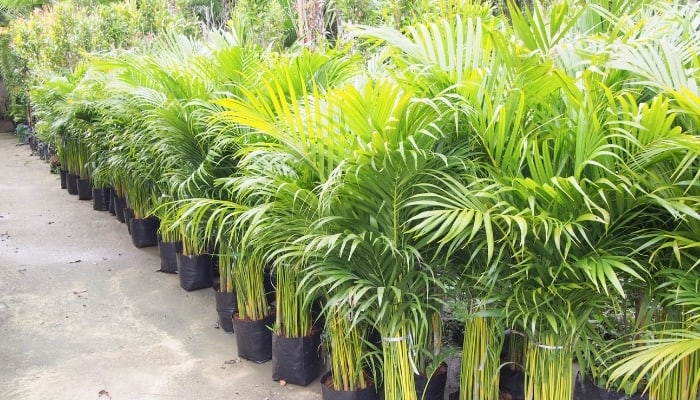
Palm trees are very popular decorative trees, used indoors and out.
Palms can be sensitive to transplant and environmental changes when young and have high water and nutrient needs, but once they mature they stabilize and become hardier. These trees do best in warmer climates and do not tolerate cold winters.
Miniature potted palm trees are great to sell as indoor plants. These bring some tropical beauty into your customer’s home, apartment, or office.
Large varieties for outdoor use are essential fixtures in landscaping across the warm regions of the U.S. These can be sold wholesale to landscape companies or sold directly to customers.
Ornamental Trees

Growing ornamental trees means growing specific types and varieties that are prized for their appearance. These trees aren’t specifically grown for fruits, nuts, or wood, but rather for their decorative properties.
Many of them have bright and unique colored leaves or flowers or have attractive shapes.
Examples of ornamental trees include Japanese Maple, Weeping Willow, Eastern Redbud, Dwarf Koren Lilac, and many more.
These trees can be sold to landscaping companies, garden centers, or directly to customers. Many ornamental trees are somewhat difficult to grow and highly sought after, making them incredibly valuable.
Pros & Cons of Growing Trees For Money
Before starting any business it’s important to see both sides of the equation.
There are many aspects to tree farming that make it seem almost too good to be true, but there are difficulties and drawbacks too.
Here are the pros and cons of growing trees for money.
PROS of Growing Trees for Profit
Stable business – Trees are long-lasting plants and are much more hearty than things like shrubs or vegetables. There tends to be less volatility in tree farming than other kinds of farming.
Great way to utilize land – As a farmer or landowner, you want all of your land working for you. By planting trees, even low-maintenance ones, you can make better use of your property and bring in steady, long-term income.
Diverse opportunities – Most tree systems have the potential for multiple sources of income. For example, walnut trees provide yearly income in the form of nuts as well as long-term income as valuable wood after decades.
Also, the food products of many trees, like apples, have dozens of uses. You can sell fresh apples during harvest season and use the damaged and less attractive apples for cider which extends income into the winter months.
CONS of Growing Trees for Profit
Large initial costs – Starting a nursery, orchard, or forest requires a significant amount of capital, loads of planning, and some expertise. Getting your business up off the ground will be expensive and time-consuming.
Long wait for income – Unless you are selling young tree seedlings, you likely won’t see any profits for years. Fruit and nut trees take anywhere from three to ten years to yield and trees grown for wood can take ten to fifty years.
Growing trees in cycles is tricky but essential if you want a stable tree farming business. If you need profits in the short term, tree farming isn’t for you.
You Should Start A Tree Farm If…
If you enjoy working outdoors and aren’t afraid to invest upfront and wait years for returns, a tree farm may be for you.
What turns many growers off is the overhead and the patience that is required to start. There is no fast money in tree farming.
Going into this business, you should be ready to study your market and thoroughly plan out your growing system before spending any money. With trees, it’s all about looking forward three, five, or ten years into the future.
Once you get over the hump of setup, the business becomes easier to manage and relatively hassle-free. The great thing about tree farms is their stability once built properly.
The most important factor when deciding if this is right for you comes down to your personality and interests. Tree farmers are hardworking and organized people. They love plants and want to spend their days outdoors, but aren’t afraid of paperwork and planning.
If this all sounds like you, tree farming may just be your calling.
Tree Farm Success Stories
Grace quit her job to become an avocado farmer. She made a three-year plan, took the dive, and changed her life to follow her passion. Today she has over 20,000 trees on her avocado farm.
She loves that now that the initial work is done, the business is stable and managing the orchard isn’t a hassle.
Mike’s Backyard Nursery
Mike McGroarty parlayed a high school nursery job into a landscaping company, only to come full circle back to growing trees for profit years later.
He went from losing his last $1.79 to the IRS in 1983 to appearing on the cover of Mother Earth News and selling thousands of books on how to grow trees a few years later.
Today, Mike is one of the premier tree nursery gurus and a true pioneer of the space.
Jonathan Saperstein leads a massive family-run nursery business called Tree Town USA. The company has sixteen growing facilities across the U.S. Jonathan says that Tree Town is a manufacturing business at heart.
He is proud that data, robotics, and innovation are the driving factors in his company’s growth and future.
Common Questions
How many trees can you plant per acre?
How many trees you plant per acre depends on what type of tree you want to grow. On top of that, there are several spacing options for each type of tree, each with its pros and cons.
If you were to plant an orchard of apples, a common setup would be 16 feet between each tree and 20 feet between each row. This comes out to 136 trees per acre.
Another option would be to leave 12 feet between each plant and 20 feet between each row, or 182 trees per acre.
A high-density system for apples can even be as tight as 3 feet between trees and 12 feet between rows, 1,210 per acre.
More spacing creates a more comfortable pedestrian experience, perfect for “pick your own” orchards, but is less efficient.
Dense plantings are the most efficient use of space, but require more vigilance in terms of soil nutrition and tree disease and are difficult to harvest.
If you are growing directly in pots, spacing becomes more simple. Still, your pruning and overall growing system will define exactly how close or far those pots should be.
If you want to see how many trees you can fit per acre across different planting systems, you can use a tree spacing calculator.
Can you have a tree farm in your backyard?
Yes, across the United States you can legally grow trees and other plants in your backyard or front yard. Beyond this, it just comes down to how much space you have available.
Small nurseries can certainly fit in a backyard. Fruit and nut trees will be harder to turn a profit on with very small spaces, but it can be done, especially if you’re willing to grow them in containers.
Farming trees for wood isn’t something most people can do in their backyard. It generally takes acreage to do this. You can certainly plant some wood trees in your yard, but a timber business is most likely out of the scope of most of our yards.
For nurseries and food products, starting in your backyard is a great idea as it allows you to test out your business before moving to a larger growing space.
Once you have gotten some experience and figured out if tree farming is something you truly enjoy, leasing or buying land is the next logical step.
Choose from Thousands of Trees & Plants, Delivered with Care, Directly to Your Home.
- Indoor/Outdoor
- Fruit/Flower
- Privacy/Decorative
- and more!


